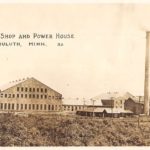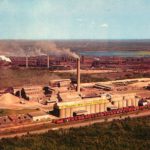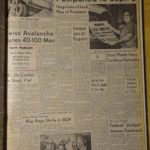Morgan Park: Remembering Our Past
Retired Duluth Fire Chief John Strongitharm put together this half-hour photo slideshow depicting the history of Duluth’s Morgan Park neighborhood. It’s been 50 years since United States Steel announced it would begin phasing out its Duluth Mill operations, but much of the Model Community it created in the early 20th century remains.
United States Steel Duluth Works was the largest steel mill north of Chicago, employing nearly 3,000 people at its peak in the early 1960s. It was first proposed by U.S. Steel in 1907, when state lawmakers coerced the company to build the mill in Minnesota to avoid a tax on exported ore.
U.S. Steel also built the Morgan Park neighborhood as a company town for its workers to live. Both construction projects began in 1913. U.S. Steel owned the houses, which were all made of concrete blocks and rented exclusively to employees.
The town took the name Morgan Park in 1914 as a tribute to J. P. Morgan, the financier who helped organize U.S. Steel. Production began at the mill the next year. U.S. Steel worked with area mining interests to produce rich grade iron ore. The mill steel helped build ships in Duluth shipyards that were used in two world wars.
The company-owned Lake View Store was built in 1915. It had a butcher shop and stores selling shoes, clothing, hardware, furniture, pharmaceuticals and groceries. The top floor had a bank, dentist office, barber shop, hair salon, hat shop, billiard room and auditorium. The basement had an ice-making plant which made eight tons of ice per day for the mall and for Morgan Park residents.
Morgan Park School opened in 1916, serving grades 1-8. High school classes were added in 1918. The high school was closed by the Duluth School Board in 1982 due to declining enrollment. The school continued as a junior high until 2012 and demolition of the building began in 2017.
The Goodfellowship Club was built in 1917. It had an auditorium, pool, billiard room, bowling lanes, a squash room, gymnasium, dining room and lounges. It was demolished in 1981 and replaced by a smaller building.
Duluth annexed Morgan Park in 1933, ending the independent police and fire department. In 1942, U.S. Steel hired a real estate company to sell the houses to employee residents and other interested home buyers.
Following World War II, demand for iron ore began to decline, along with the availability of rich deposits. The plant began to cut back, producing about 1 million tons of steel per year during the 1950s and ’60s.
In 1970 the Minnesota Pollution Control Agency demanded U.S. Steel provide documentation on pollution output and implement a plan to meet standards. Also, shipping costs went up due to a weak regional economy while foreign competition and technological advances in the industry took a toll on the company.
In 1971 members of the community formed a business/labor partnership and attempted to persuade the Minnesota Legislature to give U.S. Steel an incentive package by freezing real estate taxes for up to 13 years if the company would modernize its facility to employ a new process of mining taconite pellets. The bill failed to pass the senate, on a 33-33 vote.
The blast furnace closed first. Two years later, cold-side production units were stopped. In 1976 the cement plant closed, followed by the coke plant in 1979. Most of the steel plant buildings were torn down by 1988. A majority of the land-based contamination on the site has been addressed, but it remains on both the federal National Priorities List and State of Minnesota Permanent List of Priorities, primarily due to sediments in the St. Louis River. Ikonics Corporation has occupied the 11-acre southwest portion of the site since 2008.
Recommended Links:
Leave a Comment
Only registered members can post a comment , Login / Register Here














No Comments